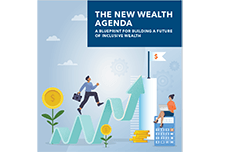Among the truly urgent crises facing the United States is widespread household financial insecurity. A stunning 51% of U.S. households have expenses that are at least equal to—if not greater than—their income, and 55% lack the necessary savings to weather a simultaneous income drop and expense spike. And the bottom 50% of the population holds just 3% of the nation’s wealth. To effectively address the financial precarity engulfing millions of U.S. households, we need a bigger, bolder response that can both serve as the primary organizing principle for the great work on financial security that is happening across the nation and galvanize more people to get involved.
In The New Wealth Agenda: A Blueprint for Building a Future of Inclusive Wealth, the Aspen Institute Financial Security Program offers a goal that is equal parts ambitious and achievable: By 2050, we must increase by ten-fold the wealth of households of color and those in the bottom half of the wealth distribution in the United States. In the report, we identify the eight objectives that we believe are the most effective path forward for reaching that goal. We also pinpoint the critical indicators to track and assess our collective progress toward creating the conditions of financial security and well-being that will enable full participation, agency, and dignity in our economy, and a new future of wealth.




